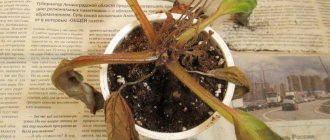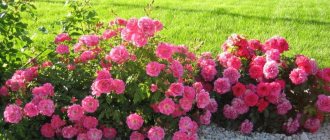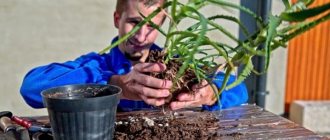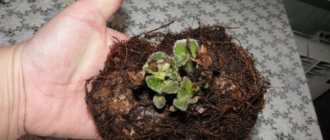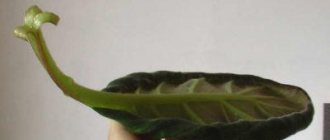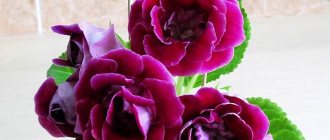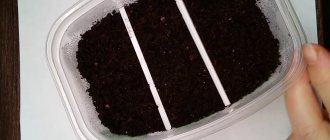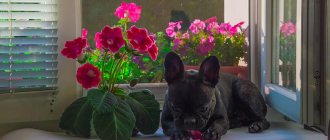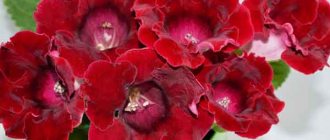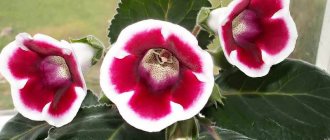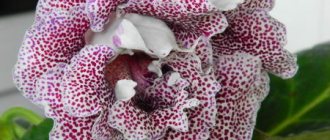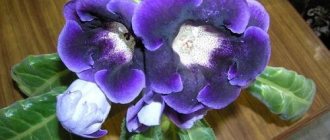Gloxinia (botanical name - Sinningia beautiful) is a tuberous perennial plant of the Gesneriaceae family with bell-shaped flowers of a wide range of colors and velvety fragile leaves. With proper care, your pet blooms twice a year, delighting you with beautiful delicate buds.
Planting tubers is one of the ways to breed gloxinia. Let's look at 5 useful tips on how to do it right.
Which pot is suitable?
The roots of this tuberous plant develop horizontally, so for gloxinia they choose pots that are wider than they are tall .
The size of the container should not be too large so that excess wet soil does not become a source of fungal infections. It is best if the diameter of the pot is only 4-6cm larger than the diameter of the tuber.
To ensure breathability, you should choose a ceramic planting container without a continuous layer of glaze .
Top dressing
Gloxinia is fed once every ten days. Fertilizing begins when the plant breaks dormancy and shoots develop from the tuber. Stopped in mid-August. Fertilizers are applied an hour after the main watering along the edges of the pot, avoiding contact with the leaves and growing point.
You can prepare plant food yourself . To do this, take 10 liters of water:
- 10g. simple superphosphate;
- 0.1g. ferric chloride;
- 0.004g. copper sulfate;
- 0.07g. boric acid;
- 10g. potassium chloride;
- 4g. ammonium nitrate;
- 5g. magnesium sulfate;
- 0.05g. manganese sulfate;
- 0.008g. zinc sulfate.
Gloxinia flower: planting and care at home
Optimal soil
Basic soil requirements for gloxinia: moisture and air permeability, nutritional value, slightly acidic reaction and sterility .
A suitable soil mixture can be purchased at a flower shop - this is soil for violets , related to gloxinias.
Options for self-prepared planting substrates:
- Planting gloxinia in vermiculite - one part of peat and leaf soil with half of sand or vermiculite;
- one part of turf soil, humus, sand and two parts of leaf humus.
Before planting, the prepared soil must be sterilized .
Tuber: diagnosis, preparation
A tiny sprout that appears from the upper recess of the tuber in February or March, less often in January , signals readiness for planting.
The tuber is completely freed from old soil and the remains of dried roots from the previous season. They carefully inspect, identifying even the slightest signs of damage, rot or mold. If such damage is found, the affected areas are removed , the injured areas are sprinkled with charcoal powder and allowed to dry for 24 hours .
If the tuber is limp, wrinkled in moistened (but not wet) vermiculite for the same period . The advantage of such a substrate is its guaranteed sterility, sufficient moisture capacity and environmental friendliness. If the sprouts are barely noticeable, you can completely cover the tuber with vermiculite. Formed sprouts should be left on the surface.
A tuber that does not germinate for too long should be awakened . To do this, it is carefully inspected, possible damage is removed, washed and placed in a plastic bag, at the bottom of which there is a handful of damp, light soil. Tie this bag tightly and place it in a very light and very warm (24 to 26 degrees) place. Sprouts appear in about two weeks.
Tubers completely ready for planting and immersed for 20-30 minutes in a solution of fungicide or potassium permanganate , making sure that the antiseptic does not get on the tender sprouts. You can also carry out pre-planting treatment with a root formation stimulator .
How to plant tubers
In February-March, the tubers germinate. They are removed from the ground and cleaned of old roots and soil particles. Then they are disinfected for about half an hour in a weak solution of potassium permanganate. The detected rot is cut off with a sharp knife, and the cut is sprinkled with crushed coal.
The tuber is planted in the ground and lightly sprinkled with soil, leaving the sprouts exposed. Expanded clay or foam is poured onto the bottom of the pot for drainage. Overmoistening of the soil leads to rotting of the tuber, so watering must be done carefully with a small amount of water.
If there is little planting material, potatoes can be cut into several slices with a sprout on each, treat the cuts with charcoal and plant in pots, covering them with bags. It is important to choose the right pot - it should be 3-5 centimeters larger than the tuber.
Soil level
The prepared soil mixture is poured onto the drainage layer and the tuber so that it is covered with soil only two-thirds of its height .
A feature of the development of gloxinia is the advanced growth of leaves - the roots grow noticeably later. Therefore, you need to water the planted tuber moderately and carefully, especially making sure that water does not fall on the rosette of young foliage.
When a short stem is formed, add soil so that it covers the tuber with about a centimeter layer.
Read more about how to care for gloxinia at home.
What kind of land is needed for gloxinia
Soil for spathiphyllum - what kind of soil is needed for a flower
The abundance of flowering and the presence of immunity to diseases depend on the quality of the earthen substrate. What soil is suitable for a gloxinia flower? The following compositions can be used as nutritional mixtures:
- Turf soil, soil soil, peat and sand.
- Peat, sapropel, river sand, vermiculite and lime flour. This composition can be obtained using a ready-made soil mixture - Biosoil "Ecoflora".
- Turf soil, river sand, peat, sphagnum, charcoal and microfertilizers. These substances are present in the ready-made soil “Gardens of Aurica”.
Ready substrate for indoor flowers
Land for gloxinia is selected depending on the crop variety. Very often, preference is given to ready-made nutrient substrates. The most common mixture for begonias is “Garden of Miracles”.
Photo
Next you can see a photo of Gloxinia planting:
The process of growing gloxinia cannot be called easy and problem-free, so it is important to know the basic rules of care. On our website you will find articles on how to propagate a plant and a detailed description of possible diseases and pests.
Description of the species
Gloxinia is a popular perennial flower of the Gesneriaceae family . The name comes from Latin and means “bell.” This name is very appropriate, since gloxinia flowers are very similar to fluffy bells. Gloxinia flowers come in a variety of colors and shades. This flower is persistent and strong. It is classified as a tropical plant. This flower needs a lot of light.
The plant is very finicky and lack of light will affect its growth and productivity. Normal growth requires 12 to 14 hours of light. The scientific name of the flower is Gloxinia Sinningia. It is a perennial tuberous plant with a short stem and thick, dark green, velvety leaves. The flower is very popular and attracts many with its appearance.
Regulating soil acidity
You cannot plant flowers in soil with high acidity; the pH value should not exceed 6-6.5. In an acidic environment, plants are inhibited and may die. Dolomite flour is used to lower the acid level. This is, in fact, ordinary limestone, ground into flour. Add it in small portions, depending on the indicators.
Advice! Acidity indicators are available in specialized stores. With its help, it is easy to determine the acid level and eliminate the problem in time.
If the buds begin to fall off without opening, the lower leaves turn yellow and fall off - this is also a sign of low acidity, which means the plant lacks phosphorus and nitrogen. In this case, eggshells help. It is thoroughly washed, dried, and pounded in a mortar. Add little by little, no more than 10 g per 0.5 kg of soil. It is effective to water the ground with a solution of wood ash: 1 teaspoon per 2 liters of settled water.
Selection of ready-made substrate
You don’t have to think too hard when choosing ingredients for planting cacti. Ready-made soil for these plants can be purchased at most stores that specialize in selling indoor plants.
The advantages of this choice are obvious. It is not always possible to find ingredients suitable for creating a mixture. The origin of gravel is not always known, and there may even be doubts about its composition. Therefore, sometimes it is better to purchase a ready-made substrate compiled by specialists. However, we must remember that the basis of most ready-made soils is peat, and its high content is undesirable for cacti
When choosing a ready-made substrate, you should pay special attention to this ingredient.
The best soil composition for cacti can be considered:
- based on lowland peat;
- classified as “fertilized”.
The importance of choosing the right size
It is better not to plant small tubers in containers that are too wide. This will lead to the fact that gloxinia will increase its root and leaf mass, postponing flowering for a long time (you can find out more about why gloxinia does not bloom and what to do about it here).
In a pot with a diameter of less than 9 centimeters, gloxinia will feel cramped , there will be little soil and it will often dry out.
Due to the lack of sufficient space, the plant may begin to wither and shed its leaves.
Air humidity
Air humidity should be in the range of 70-80%, but gloxinia feels good even at a lower humidity of 50%, however, even lower humidity is undesirable, the plant develops poorly, growth slows down and deformation of the leaves occurs. The edges of the leaf blade are bent downwards.
To increase air humidity, you can place the plant on trays with wet expanded clay, moss, water, but gloxinia itself cannot be sprayed because brown, dry spots form. However, away from light and drafts, gloxinia tolerates water treatments very well. At night, you can take it into the bathroom, spray it or wash it with warm water and leave it there with the doors closed and the lights off until the water on the leaves has completely dried.
